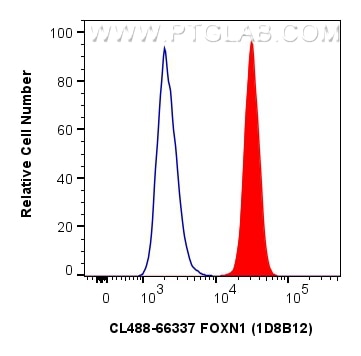Validation Data Gallery
Tested Applications
| Positive FC (Intra) detected in | A549 cells |
Recommended dilution
| Application | Dilution |
|---|---|
| Flow Cytometry (FC) (INTRA) | FC (INTRA) : 0.40 ug per 10^6 cells in a 100 µl suspension |
| It is recommended that this reagent should be titrated in each testing system to obtain optimal results. | |
| Sample-dependent, Check data in validation data gallery. | |
Product Information
CL488-66337 targets FOXN1 in FC (Intra) applications and shows reactivity with human samples.
| Tested Reactivity | human |
| Host / Isotype | Mouse / IgG1 |
| Class | Monoclonal |
| Type | Antibody |
| Immunogen | FOXN1 fusion protein Ag18207 相同性解析による交差性が予測される生物種 |
| Full Name | forkhead box N1 |
| Calculated molecular weight | 648 aa, 69 kDa |
| Observed molecular weight | 60 kDa |
| GenBank accession number | BC146539 |
| Gene Symbol | FOXN1 |
| Gene ID (NCBI) | 8456 |
| RRID | AB_3084235 |
| Conjugate | CoraLite® Plus 488 Fluorescent Dye |
| Excitation/Emission maxima wavelengths | 493 nm / 522 nm |
| Form | Liquid |
| Purification Method | Protein G purification |
| UNIPROT ID | O15353 |
| Storage Buffer | PBS with 50% glycerol, 0.05% Proclin300, 0.5% BSA , pH 7.3 |
| Storage Conditions | Store at -20°C. Avoid exposure to light. Stable for one year after shipment. Aliquoting is unnecessary for -20oC storage. |
Background Information
FOXN1, also named as Forkhead box protein N1, is a 648 amino acid protein, which contains 1 fork-head DNA-binding domain and localizes in the nucleus. FOXN1 as transcriptional regulator regulates the development, differentiation, and function of thymic epithelial cells (TECs) both in the prenatal and postnatal thymus. FOXN1 acts as a master regulator of the TECs lineage development and is required from the onset of differentiation in progenitor TECs in the developing fetus to the final differentiation steps through which TECs mature to acquire their full functionality.
